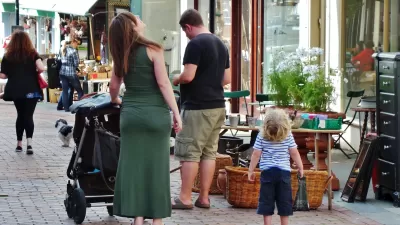According to Haya El Nasser, cities across America have succeeded in attracting young professionals for over a decade. “They came, they played, they stayed,” she writes. But, she asks, will these Millennials stick around as they age and have kids?
Richard Florida and Bill Fulton agree, Millennials not only move often, but they are also “the generation that decides where it's going to live before it decides what it's going to do.” This means that cities need to not only attract Millennials early on in adulthood, but also provide the amenities to keep them there in the long-term. Fulton asserts "capturing people early on in their lives in a metro really matters. It's important to compete with suburbs for people once they get a little older and have children." As Millennials age, cities will need to provide more than “hip entertainment venues and small flats," but also, “soccer fields, good schools and roomy homes,” Fulton says. "The question isn't so much getting families out of the suburbs into cities but getting them to stay in the cities."
According to Nasser, “The growing urban constituency of hipster parents is not timid about making itself heard," pointing out that "[e]ducated and in professional jobs, they are equipped to organize and galvanize.” Among other things, they demand safe neighborhoods, high quality schools, and larger 3-4 bedroom homes within cities, rather than in the suburbs. They also want access to other urban amenities near transit, which they are more likely to use, including grocery stores and childcare. Mayors, councilman and developers alike are responding to these demands in different ways: by endorsing school choice and charter schools, by investing in “quality of life” infrastructure and urban parks, and by building suburban housing environments in cities.
"We have professionals come and go, singles come and go," says downtown Los Angeles Councilman, Jose Huizar, "But you build for families, and they're here to stay." By building for families first with those amenities that also attract young adults, cities have much to gain. In doing so, they are fostering a stable tax base and continued economic activity as Millennials moves into family-hood.
FULL STORY: American cities to Millennials: Don't leave

Americans May Be Stuck — But Why?
Americans are moving a lot less than they once did, and that is a problem. While Yoni Applebaum, in his highly-publicized article Stuck, gets the reasons badly wrong, it's still important to ask: why are we moving so much less than before?

Using Old Oil and Gas Wells for Green Energy Storage
Penn State researchers have found that repurposing abandoned oil and gas wells for geothermal-assisted compressed-air energy storage can boost efficiency, reduce environmental risks, and support clean energy and job transitions.

Placekeeping: Setting a New Precedent for City Planners
How a preservation-based approach to redevelopment and urban design can prevent displacement and honor legacy communities.

San Francisco’s Muni Ridership Grew in 2024
The system saw its highest ridership since before the Covid-19 pandemic, but faces a severe budget shortage in the coming year.

Colorado Lawmakers Move to Protect BRT Funding
In the face of potential federal funding cuts, CDOT leaders reasserted their commitment to planned bus rapid transit projects.

Safe Streets Funding in Jeopardy
The Trump administration is specifically targeting bike infrastructure and other road safety projects in its funding cuts.
Urban Design for Planners 1: Software Tools
This six-course series explores essential urban design concepts using open source software and equips planners with the tools they need to participate fully in the urban design process.
Planning for Universal Design
Learn the tools for implementing Universal Design in planning regulations.
Heyer Gruel & Associates PA
City of Moreno Valley
Institute for Housing and Urban Development Studies (IHS)
City of Grandview
Harvard GSD Executive Education
Salt Lake City
NYU Wagner Graduate School of Public Service
City of Cambridge, Maryland





























